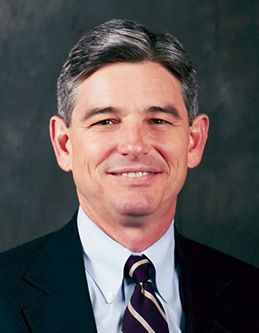Stewardship, Sacrifice, and Ownership
President of the BYU Alumni Association
April 26, 2007
President of the BYU Alumni Association
April 26, 2007
Just as you have passed through the halls at BYU, I hope the Spirit of the Y has passed through you and become a part of you.
It is my great pleasure to represent the Brigham Young University Alumni Association at these commencement exercises. On a personal note, I should tell you that in January of this year my wife, Bertha, and I celebrated the payment of our last tuition bill. Our youngest child, Heather, is with us today as a graduate, and no two people are prouder or happier for her than are we.
As new graduates, many of you may be focusing on the possibilities that lie ahead to create wealth for yourselves. Might I suggest that you consider wealth creation as a commodity made up of financial, human, and intellectual capital. Business people know that they must spend 70 to 80 percent of their time growing assets. In families, growing the human and intellectual assets is often overlooked. The members in the family are the human capital. Their collective life experiences and knowledge make up the intellectual capital. The financial capital supports the growth of the other two. James E. Hughes, Jr., suggests these concepts to us in his book, Family Wealth.
He reminds us that
in the mid-eighteenth century, Mayer Amschel Rothschild founded the House of Rothschild. This creator of the Rothschild fortune had five sons, each of whom he set up in the banking business in one of the era’s five principal European financial capitals: Frankfurt, Vienna, London, Paris, and Naples. He lent them the money to get started at lower than normal interest with the proviso that they pay him back. He directed that each son keep the profits of his individual bank once the original loan had been repaid. He also charged interest in the form of intellectual currency. He requested each of his sons relay to him every bit of financial information he gained in his city. He agreed to share this intellectual interest with his other sons. In modern terms, he created an effective information network.
Mayer Amschel Rothschild also used a powerful investment technique to manage the risk to his family’s human capital. By sending each son to a different city, he diversified his human assets into five separate investments, thereby increasing the probability that at least one of the branches would survive political and economic risks. Ultimately, only the London and Paris branches survived and continue to prosper. Today, some 250 years later, the name Rothschild is synonymous with wealth. [James E. Hughes, Jr., Family Wealth: Keeping It in the Family: How Family Members and Their Advisers Preserve Human, Intellectual, and Financial Assets for Generations (Princeton: Bloomberg Press, 2004), 32; adapted by permission]
Mayer Amschel Rothschild understood that two important elements of a family’s wealth are its human and intellectual capital. He saw to it that all family members were well educated and that they worked. He also provided specialized mentorship opportunities as his sons entered the workforce.
Like the Rothschild children, you have been given a figurative loan, if you will, in the form of a financial subsidy of your tuition by The Church of Jesus Christ of Latter-day Saints. You represent the human and intellectual capital of your own families and, in a broader sense, of the Church.
You have been carefully schooled and taught while here. Many of you have had stewardship opportunities as undergraduates in mentored learning experiences with faculty—experiences usually reserved only for graduate students. On Sundays and other times during the week you have had chances to provide charitable service in your wards and in the community, volunteering and sacrificing your precious study time for those timeless elements of spiritual development that will serve you well later in this life and in the life to come. I hope you have captured stewardship training on how to be good, upstanding citizens of this peaceable country and how to be keepers of your faith.
We often refer to the warm feelings we have on campus as the Spirit of the Y. Having experienced that spirit, you can now go forth and continue to cultivate it wherever you may reside. As you give back with your time, talent, and treasure to your alma mater, you will perpetuate the process that has been going on here since 1875 when Brigham Young started this school with the charge to its first principal, Karl G. Maeser, that he “ought not to teach even the alphabet or the multiplication tables without the Spirit of God”—or, in other words, he should provide secular learning in the household of faith (in Reinhard Maeser, Karl G. Maeser: A Biography by His Son [Provo: Brigham Young University, 1928], 79).
As its president, I hereby confer on each of you lifetime membership in the Brigham Young University Alumni Association. I congratulate you and welcome you most warmly into this great association of nearly 360,000.
Just as you have passed through the halls at BYU, I hope the Spirit of the Y has passed through you and become a part of you. May your every dream and worthy aspiration become reality I pray in the name of Jesus Christ, amen.
© Brigham Young University. All rights reserved.

J. Craig McIlroy was president of the BYU Alumni Association when this commencement address was given on 26 April 2007.